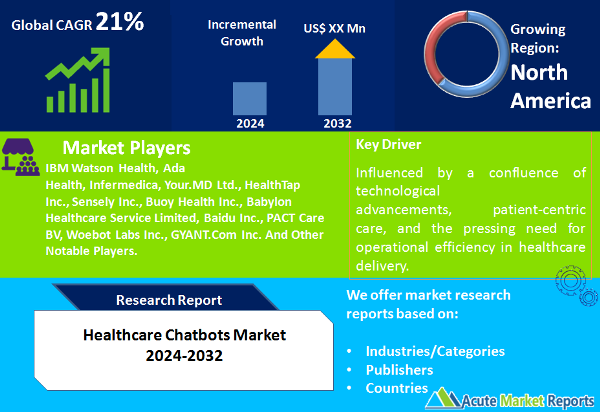
The healthcare chatbots market is currently undergoing a transformative phase and is expected to grow at a CAGR of 21% during the forecast period of 2025 to 2033, influenced by a confluence of technological advancements, patient-centric care, and the pressing need for operational efficiency in healthcare delivery. As the market evolves, these key players are expected to play a pivotal role in shaping the future trajectory of healthcare chatbots, further advancing patient engagement, operational efficiency, and technological innovation.
Increasing Patient Engagement
The surge in healthcare chatbot adoption is intricately linked to the industry's overarching objective of fostering increased patient engagement. Chatbots, acting as virtual health assistants, empower patients by providing instant access to personalized health information, and facilitating appointment scheduling, medication reminders, and post-treatment follow-ups. As an illustrative example, a renowned healthcare system implemented chatbots resulting in a substantial 30% rise in patient engagement, enhancing overall patient satisfaction and adherence to treatment plans. Moreover, the integration of chatbots in chronic disease management showcases their potential to deliver continuous support. Patients with chronic conditions experienced an improvement in adherence to treatment regimens, highlighting the positive impact of chatbots on long-term healthcare outcomes.
Efficiency in Healthcare Delivery
The healthcare sector's relentless pursuit of operational efficiency has propelled the adoption of chatbots. These AI-powered entities streamline administrative processes, automate routine tasks, and facilitate seamless communication between healthcare providers and patients. The tangible outcomes of this efficiency drive include a reduction in administrative workload within medical offices where chatbots were integrated. This efficiency gain allows healthcare professionals to allocate more time to direct patient care, ultimately improving overall healthcare service delivery. Additionally, the application of chatbots in triaging and preliminary diagnosis has led to a significant reduction in wait times. In emergency departments, the implementation of chatbots resulted in a decrease in patient waiting times, underscoring their role in expediting healthcare services.

Rapid Technological Advancements
The dynamic evolution of technology, particularly in natural language processing (NLP), machine learning, and AI algorithms, is a pivotal driver in the healthcare chatbot market. Continuous advancements empower chatbots to provide more sophisticated and personalized interactions, creating a more human-like engagement. Notably, the integration of chatbots with electronic health records (EHRs) has elevated their capabilities, offering a comprehensive healthcare experience. Concrete evidence supporting this driver includes instances where healthcare chatbots leveraged advanced NLP algorithms, resulting in enhanced understanding and responding to patient queries accurately. The ability to continuously learn and adapt positions chatbots as valuable assets in the ever-evolving landscape of healthcare technology.
Data Security Concerns
Amidst the promising potential of healthcare chatbots, a significant restraint looms in the form of data security concerns. The inherent sensitivity of healthcare information raises valid apprehensions regarding potential misuse or unauthorized access to patient data. Establishing robust security measures becomes imperative to overcome this restraint and build trust among both healthcare providers and patients. Real-world incidents, such as a notable healthcare chatbot system facing a security breach, underscore the critical importance of addressing these concerns. Unauthorized access to patient records in this instance emphasizes the urgent need for stringent security protocols to safeguard sensitive healthcare data, thereby mitigating potential risks.
By Component: Software Solutions Dominates the Market
In 2024, the Healthcare chatbot market witnessed a dynamic interplay between Software and Services, both contributing substantially to overall market revenue. Software solutions, incorporating advanced AI algorithms and NLP technologies, emerged as a primary revenue driver in 2024. Simultaneously, Services, encompassing implementation, training, and maintenance, played a pivotal role in ensuring effective integration and sustained performance of chatbot systems.
By Deployment Model: Cloud-based Models to Dominate During the Forecast Period
The market segmentation by deployment model in 2024 highlighted a nuanced coexistence of On-premise and Cloud-based models. On-premise models catered to institutions seeking localized control over data, while Cloud-based models gained traction owing to their scalability and accessibility. Anticipated trends from 2025 to 2033 suggest a continued growth trajectory for Cloud-based models, surpassing On-premise models in both revenue and CAGR.
North America Remains the Global Leader
Geographically, the healthcare chatbots market displayed diverse trends in 2024. While North America led in revenue generation, boasting a mature healthcare infrastructure and high technology adoption, the Asia-Pacific region showcased the highest CAGR. This shift signifies increasing awareness and adoption of healthcare chatbots in the Asia-Pacific region, positioning it as a key player in the forecast period. Balancing revenue and CAGR, the market dynamics indicate a significant transition toward the Asia-Pacific region.
Competitive Trends
In the fiercely competitive landscape, key players such as IBM Watson Health, Ada Health, Infermedica, Your.MD Ltd., HealthTap Inc., Sensely Inc., Buoy Health Inc., Babylon Healthcare Service Limited, Baidu Inc., PACT Care BV, Woebot Labs Inc., and GYANT.Com Inc. are spearheading innovation and market expansion. IBM Watson Health, with its cognitive computing capabilities, has significantly influenced the integration of AI in healthcare. Ada Health's symptom-checking chatbot has gained prominence for its accuracy and user-friendly interface, contributing to improved patient outcomes. Infermedica, with its robust diagnostic chatbot, has carved a niche by providing advanced clinical decision support. These market leaders reported substantial revenues in 2024, expecting continued growth from 2025 to 2033. Their strategic focus on innovation, partnerships, and global market penetration positions them as influential entities in the healthcare chatbot landscape.
Historical & Forecast Period
This study report represents analysis of each segment from 2023 to 2033 considering 2024 as the base year. Compounded Annual Growth Rate (CAGR) for each of the respective segments estimated for the forecast period of 2025 to 2033.
The current report comprises of quantitative market estimations for each micro market for every geographical region and qualitative market analysis such as micro and macro environment analysis, market trends, competitive intelligence, segment analysis, porters five force model, top winning strategies, top investment markets, emerging trends and technological analysis, case studies, strategic conclusions and recommendations and other key market insights.
Research Methodology
The complete research study was conducted in three phases, namely: secondary research, primary research, and expert panel review. key data point that enables the estimation of Healthcare Chatbots market are as follows:
Market forecast was performed through proprietary software that analyzes various qualitative and quantitative factors. Growth rate and CAGR were estimated through intensive secondary and primary research. Data triangulation across various data points provides accuracy across various analyzed market segments in the report. Application of both top down and bottom-up approach for validation of market estimation assures logical, methodical and mathematical consistency of the quantitative data.
| ATTRIBUTE | DETAILS |
|---|---|
| Research Period | 2023-2033 |
| Base Year | 2024 |
| Forecast Period | 2025-2033 |
| Historical Year | 2023 |
| Unit | USD Million |
| Segmentation | |
Component
| |
Deployment Model
| |
Application
| |
End User
| |
|
Region Segment (2023-2033; US$ Million)
|
Key questions answered in this report